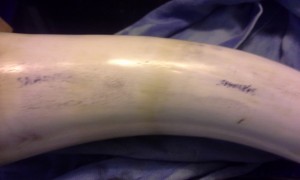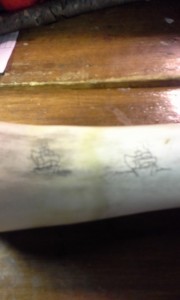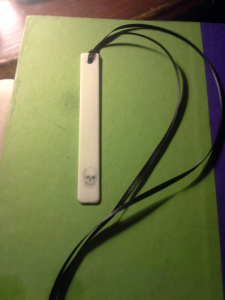 Created a scrimshaw skull bookmark for halloween as well as those who enjoy horror, suspense, who-done-it, thrillers and other scary stories. Made with a piano key tail of alternative ivory used to recover piano keys that have gone bad or become discolored, it is softer than real ivory and takes a light touch, otherwise the material shreds (when creating lines) or “craters” (raises up around the edges of stipple dots). polishes and scribes well with these things in mind. Clicking on the picture will bring it up to full-size. Available at Etsy.com
Created a scrimshaw skull bookmark for halloween as well as those who enjoy horror, suspense, who-done-it, thrillers and other scary stories. Made with a piano key tail of alternative ivory used to recover piano keys that have gone bad or become discolored, it is softer than real ivory and takes a light touch, otherwise the material shreds (when creating lines) or “craters” (raises up around the edges of stipple dots). polishes and scribes well with these things in mind. Clicking on the picture will bring it up to full-size. Available at Etsy.com
Author: Andrew Perkins
Scrimshaw on Cattle Horn
(Originally posted in our newsletter in September 2014)
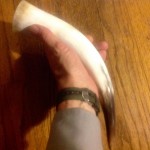 What is cattle horn?
What is cattle horn?
Cow horn is comprised of keratin, the same material your fingernails are made of, as well as hooves. Cow horn differs from Antler in the fact that antlers are actually bone with no covering, and they are often shed annually. Horns are not shed by cattle, in fact the only animal that does shed it’s keratin is the pronghorn.
Horn is somewhat thermoplastic – it can be heated and shaped, unlike ivory which takes chemical processes or carving to change its shape.
How is it used?
Horn has probably been used for items of adornment and practical use since before the domestication of the animal. From drinking vessels and helmet ornamentation to buttons, knife scales, belt buckles, and combs to powder horns and pen holders, horn can be a versatile material.
Hardness
I couldn’t find any hardness scales using the Rockler D hardness to compare it to. As far as scrimming with my Coulter scribe, it’s slightly softer and sinewy.
Colors and Source(s)
Cow horn comes in a variety of colors from black to mostly white. Usually there is some mottling often with a darker tip. The quality varies as well depending on the cattle the horn originally came from, ranging from sinewy to almost smooth. You can find cattle horn online either raw, polished or in kit form to create powder horns. One of the better places we’ve found is http://www.powderhornsandmore.com/ with a beautiful variety. They also have a newsletter to keep you apprised of shows, meetups and more. You can find other cattle horns on ebay, one of which I’d picked up and was not impressed. It is unsuitable for scrimshaw (not that it said it was scrimshaw quality), so I learned.
We picked up a “scrimshaw quality” horn from powderhornsandmore.com to work with which has been in my “scrimshaw to-do” box for some time with the intention of creating a powder horn. Sadly, with so many other projects going on it has sat there for nearly two years, and I’m sure it would sit for several more if I don’t do something with it, so we’re going to use it to test and review.
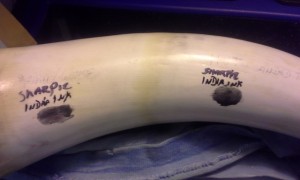 Stainability
Stainability
We lightly sanded and polished the horn further with some of the inherent texture still showing, then polished one site with “HUT PPP (Perfect Pen Polish)” wax using a Dremel tool with a felt wheel, and another site we coated with “Renaissance Wax” – a favorite polish and preservative for ivory and wood.
- Sharpie Results: Held fast until I rubbed it with nail polish remover (makes sense as it’s the same material)
- India Ink Results: wiped away easily, stayed in the crevices of the texture of the cow horn
- Oil Paint Results: wiped away easily, though stayed in the crevices of the texture of the cow horn.
Sanding completely smooth will create a cleaner image once you’ve done some scrimshaw, nail polish remover works well for cleaning it off, and the pigment does stay in the scribed lines.
Scribing
Horn has a definite grain to it running from the base to the point. This can cause some tools to stick unless they’re extremely sharp. That being said, it does scribe well. Scribing deeper may make the lines slightly “fuzzy” due to the fact that the ink will wick somewhat into the grain.
I sketched a couple of quick ships onto both sides of the polished areas to scrim. Initial cleaning left the ink as before, and most of the oil paint wiped away. Another application of nail polish remover left the ink and the oil paint in the scribed lines. Some of us (myself included) like to scribe the initial image, ink it, then fill in. this can be an issue when it comes to cow horn if you’re using nail polish remover to clean it in between scrimmings, since it not only cleans away the ink, but also removes some of the wax or polish. In case you like to work this way, we’d recommend either scribing in one sitting or scribing, cleaning, repolishing (HUT PPP was has worked the best) then let it sit for a day before moving to the detail work and shading.
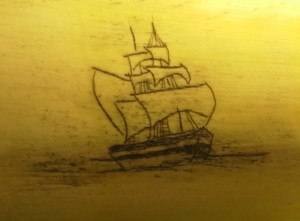 Due to the holiday weekend and relatives that flew in from Michigan and D.C., I wasn’t able to do more than this hurried test. Since cow horn is malleable, I may decide to create several smaller pieces from it after sanding it down again, having learned quite a bit from this experiment.
Due to the holiday weekend and relatives that flew in from Michigan and D.C., I wasn’t able to do more than this hurried test. Since cow horn is malleable, I may decide to create several smaller pieces from it after sanding it down again, having learned quite a bit from this experiment.
Polishing/sealing
Once you’re satisfied with your work, a final coat using either renaissance wax or HUT PPP wax works well.
Conclusions
Sanding the area you intend to scrims as smooth as possible is a prerequisite unless you are looking to keep the rougher “aged” look of your scrimshaw,
Oil paint works best, though India ink works as long as you have some nail polish remover handy
Nail polish remover will remove the wax, be sure to repolish and let the piece set up for a day before continuing if you tend to scribe/ink/scribe/ink.
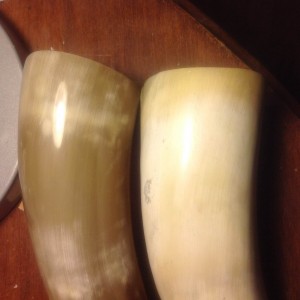 After completing this article I was talking with another scrimshaw artist who promptly sent me the horns he’d hand sanded and polished to 8000 grit then buffed with white tripoli polish. The results are night and day. Where my hasty polishing resulted in a dull finish with crevices (right), his is glass smooth (left).
After completing this article I was talking with another scrimshaw artist who promptly sent me the horns he’d hand sanded and polished to 8000 grit then buffed with white tripoli polish. The results are night and day. Where my hasty polishing resulted in a dull finish with crevices (right), his is glass smooth (left).
We’ll be resanding the white one properly before the holidays and creating something or things from it, though time still does not allow for me to create a powderhorn as intended.
Links to Materials and Suppliers
Interesting Related Link:
http://www.bladeforums.com/forums/showthread.php/1013301-My-folders horn material almost too beautiful to scrim on some beautiful custom folders.
Nantucket Basket Topper on Casein
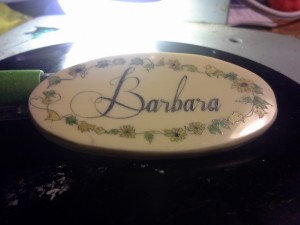 We finished and sent a scrimshaw Nantucket Basket Topper last week to a customer and wanted to share a picture of it here. We created this on a piece of casein, an alternative ivory from England which comes very close to mammoth ivory in most respects. It’s hard, not pliable like most plastic substitutes we’ve worked with as of late and scrimshaws very well provided you sand and polish it to a mirror finish. The customer requested yellow flowers other than roses, so we found several pics on Flickr of snapdragons and other wildflowers to base them on. Three coats of Renaissance Wax protects it from dust and light abrasions. While they won’t need it for awhile, we also sent 1/2 dram of the wax along with instructions on how to apply it when they need to reapply it. A little goes a long way – we’ve had our 65ml jar for over five years now and we’ just reached the 1/2 way mark.
We finished and sent a scrimshaw Nantucket Basket Topper last week to a customer and wanted to share a picture of it here. We created this on a piece of casein, an alternative ivory from England which comes very close to mammoth ivory in most respects. It’s hard, not pliable like most plastic substitutes we’ve worked with as of late and scrimshaws very well provided you sand and polish it to a mirror finish. The customer requested yellow flowers other than roses, so we found several pics on Flickr of snapdragons and other wildflowers to base them on. Three coats of Renaissance Wax protects it from dust and light abrasions. While they won’t need it for awhile, we also sent 1/2 dram of the wax along with instructions on how to apply it when they need to reapply it. A little goes a long way – we’ve had our 65ml jar for over five years now and we’ just reached the 1/2 way mark.
We have a limited amount of this material for those interested in either creating their own Nantucket Basket Topper or having one created for them. Email “questions@scrimshaw.com” and let us know your needs, we’ll do our best to fulfill your needs.
Anyone not familiar with Renaissance Wax should really become acquainted with it if they make any fine work with ivory or wood. We found after experimenting with it that it’s best to wipe it on with a soft cloth and let it sit and dry, preferably for several hours. Once it’s completely dry, using another cloth to wipe it off leaves a nice shine provided the material was polished to begin with, and will protect the ink in the incisions. When we first tried it, we wiped it on then wiped it off, similar to shoe polish (which is what it smells like). In some cases this lifted the oil paint we were using out of some of the finer lines, probably due to the fact that the paint was also not dry (the hurrier I go, the behinder I get). Using it correctly on dry surfaces works wonders.
Pyralin – aka Ivorine or Celluloid
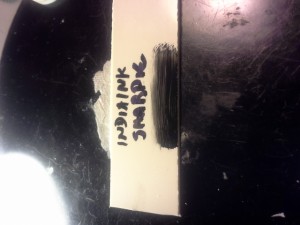
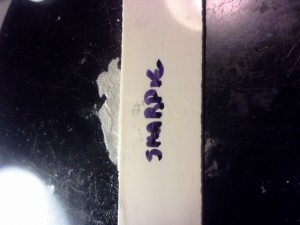
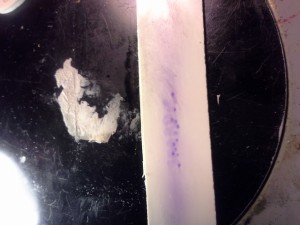
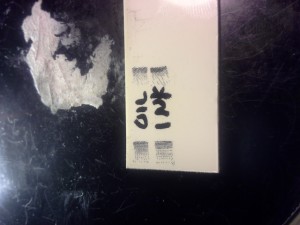
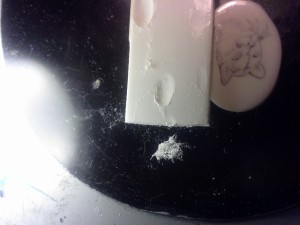
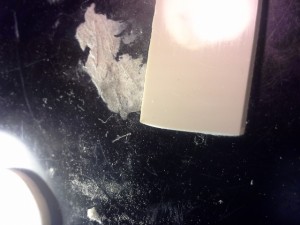
This is an excerpt from the Scrimshaw.com newsletter. You can subscribe for free and receive updates in your mailbox before they reach the website along with more information and news about scrimshaw and special sales. Look to the right (or below if you’re on a smartphone) and put in your email address to subscribe.
Pyralin is the name of a plastic created in the late 1800’s based on nitrocellulose. Nitrocellulose, also known as celluloid (see scrimshaw.com “ivory boom“), was one of the most extensively used plastics of the time. DuPont had bought the Arlington Company and used the material to replace ivory in just about every conceivable accessory of the time including combs, mirror backs, shoe horns, other personal grooming aids and beyond.
It came in a variety of colors though it was most notably used to replace ivory, so the white/cream color is what is most prevalent in the antique shops.
Pyralin was also used in the manufacture of pens, Mah Jong sets, fishing lures,
Antique pyralin commands a high price in most places, especially if it is in excellent condition. Modern pyralin is more stable, but will burn completely if it comes in contact with an open flame, burning faster than acrylic (note: most plastics will burn unless there is a flame-retardant mixed in with it).
Pyralin (at least the formulation I received) has the classic smell of camphor when it’s sanded or heated. Anyone who was in a piano store in the 1960’s or ’70’s may remember the smell (or the taste if you were young enough to still be teething and decided to gnaw on the keys).
Hardness
The material is quite flexible, and is softer than acrylic, corian and horn, but it is quite resilient.
Cutting
Using a plastic cutting tool the material cuts quite easily. A scroll saw cuts through it easily as well, making it suitable for inlay.
Stainability
We found our sharpie again, and tested India ink, Sharpie and oil paint:
India ink and oil paint wiped away cleanly while the sharpie held fast on the polished surface. Using nail polish remover only made things worse, similar to ivory. though dulling the surface of the material as well as making a complete mess.
Scribing and Stippling
The material gives so easily with the Coulter Tool it is almost like pressing into icing. Placing a stipple-dot right next to it compresses the first stipple easily. This being said, the material doesn’t raise up around it so cratering is minimal. Scribing Pyralin is very easy, the material does not dust like corian, it also doesn’t leave curls like ivory. This got me curious. I tried scratching it with my fingernail: this left no marks, which is why this material is so popular for piano keys – keratin (the material your fingernails are made of) doesn’t scratch it easily.
Polishing
Out of the box, the material has a mirror like finish. Since we’d stained the piece with the sharpie, we went ahead and sanded it down with 100,150,220,600,1000 and finally 2000 grit sandpaper and sanding pads. We were able to get close to a finish like it had originally, but it was still somewhat matte, so we brought out the dremel…
On it’s low setting, things went well until we must have reached its melting point, then things went down hill fast. The dremel slowed down and lifting it we found a divot melted into the material. We tried it a couple of more times since it was a goner anyway, the material to the left is most likely cotton fibers, a key component of pyralin/ivorine/celluloid.
Takeaway: don’t use power tools to polish.
Renaissance Wax
We applied a liberal coating of Renaissance wax to both the sanded and unsanded portion of our sample and let it dry thoroughly (with the help of a blow dryer set on low), The material retained its lustre, while the sanded portion appeared only slightly more polished. We’re wondering if the wax had any effect. It would of course, protect the pigment in any indentations or incisions made during the scrimshaw process.
Gluing
According to Mini Art Supply, the material “Can be mounted on acid-free foam core. Use 3-M Photo-Mount or 3-M Vac-U-Mount spray adhesive. These adhesives have been age-tested on Ivorine without adverse effects; other adhesives may chemically interact with the Ivorine.”
– http://www.miniartsupply.biz/MiniArt-Surfaces-2.htm
Cue stick makers recommend Duro Super Glue gel.
Summary
Pyralin/Ivorine can be a suitable alternative material for scrimshaw as long as you are aware of the following:
- It is softer than many plastics when it comes to scrimshaw yet it resists fingernail scratches easily
- Oil and India ink works well
- Do not use any solvents, especiallt nail polish remover
- Do not power polish – hand polish only
- Renaissance wax does not adversely affect it, and would protect the scribed portions.
Best Uses:
Smaller jewelry, inlay on top of wood boxes, small folding knives or occasional use knives where you need a thin layer of material, book marks (instead of piano ivory tails or heads).
Sources:
We purchased our material from http://www.vandaking.com, a company based in Canada with warehouses peppered throughout the US.
You can also find this material in sheet form at:
http://www.miniartsupply.biz/MiniArt-Surfaces-2.htm
You can find this material at other piano restoration companies, and you may have one nearby.
Billiard and pen making enthusiasts can find a similar material in rod form at:
http://www.cuestik.com/store/product.asp?DEPARTMENT_ID=171&ITEM_ID=5918, though we have not used this material and it may be a different formulation. they also have “Ivorine-3” which is linen based and may be unsuitable for scrimshaw due to the fact that it has a fabric in its makeup which might wick your pigment. At the price for even one foot of this material, we’re not ready to test it at this time.
Ending Notes
While looking for celluloid earlier this year, we found that there were next to no sources for it when searching with the exception of a few musical instrument repair sites. If you know anyone that is looking for celluloid to restore their guitar, mandolin or banjo they may want to look here. The material appears to be similar by all accounts to celluloid offered by those sites and is bright white.
Another Use for Poster Putty
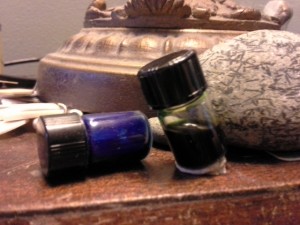 Found another use for “Poster Putty”. We’ve been using it to hold scrimshaw material in place as we scrim, but when it comes to inking the little vials I like to mix them in often end up sideways (which is why I’ve been banished from the kitchen table for all things non-food). A small dab of poster putty will hold the vial or anything else spillable fast, even if you bump into it. (small dab under the vial to the right). Available at most pharmacies and at Amazon.com
Found another use for “Poster Putty”. We’ve been using it to hold scrimshaw material in place as we scrim, but when it comes to inking the little vials I like to mix them in often end up sideways (which is why I’ve been banished from the kitchen table for all things non-food). A small dab of poster putty will hold the vial or anything else spillable fast, even if you bump into it. (small dab under the vial to the right). Available at most pharmacies and at Amazon.com.
